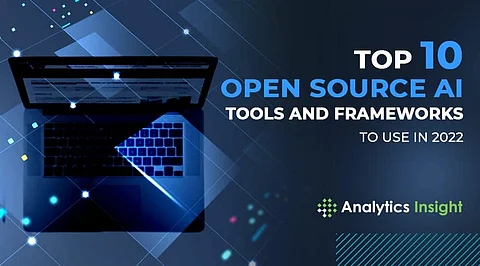Top 10 Open-Source AI Tools and Frameworks to Use in 2022

In recent years, AI tools and frameworks have made the use of AI much friendlier for the IT sector
Artificial intelligence has been around for a very long time but it was considered to be extremely difficult. It was quite common for researchers and developers to shy away from studying or using it. However, in recent years, AI tools and frameworks have made it much friendlier for the IT sector. Artificial intelligence (AI) technologies are quickly transforming almost every sphere of our lives. From how we communicate to the means we use for transportation; we seem to be getting increasingly addicted to them. Here is the list of the top 10 open-source AI tools and frameworks to use in 2022.
Theano
Theano, an open-source Python library for deep learning, is also popular in the neural processing and data science communities. It's widely known for making it easy to implement complex neural networks by abstracting away the neural network components (such as the layers and hidden layers). It's often used to build and train AI models on graphics processing units (GPUs) and has been adopted by Facebook for both training and deploying AI applications.
Tensorflow
It is an open-source library developed by Google Brain that is used to deal with complex datasets and execute high-volume numerical computations. Used by tech giants like Nvidia, Google, Intel and SAP, it allows developers to send counterfeit neural systems with massive datasets after setting up, and training them. Tensorflow certificate program follows self-paced learning in ML for foundational level along with the support of experienced Tensorflow programmers for this open-source software library.
PyTorch
PyTorch is an AI system created by Facebook. Its code is accessible on GitHub and at present has more than 22k stars. It has been picking up a great deal of energy since 2017 and is in a relentless reception development.
Caffe
Caffe is a profound learning structure that prioritizes articulation, tempo, and quantifiable consistency. The Berkeley Vision and Learning Center (BVLC) and network contributors fund it. The Caffe Framework is needed for Google's DeepDream. This is a BSD-compliant C++ library with a Python interface.
Keras
Keras is a high-level AI API that can run on top of TensorFlow, Microsoft Cognitive Toolkit, and Theano. Its ease of use and focus on the developer experience make Keras the go-to for rapidly prototyping new apps. Many brands like Netflix, Uber, and Yelp, as well as smaller startups, have integrated Keras into their core products and services. Netflix, for example, has leveraged deep learning to predict customer churn, which is crucial as a subscription-based business.
Microsoft Cognitive Toolkit (CNTK)
The Microsoft Cognitive Toolkit (CNTK) is an open-source AI framework. CNTK can be included in projects as a library in various languages or used as a standalone machine-learning tool through its model description language called BrainScript. The commercial-grade toolkit is used by Skype, Bing, Cortana, and other brands with massive datasets that require a scalable and highly optimized machine learning platform.
Flux.jl
It takes a different approach than the high-level application programming interfaces of libraries like fast.ai for PyTorch or Keras in TensorFlow. Instead of staying true to its mathematical and scientific computing roots to support coding patterns that are very similar to the equations you might read in a scientific paper describing a new ML technique. Flux.jl is used in many other Julia language machine learning projects, including DiffEqFlux.jl that we discussed earlier. For the interested beginner looking for an experience most similar to Autograd or JAX from Python, Zygote.jl, a Flux-based library for advanced automatic differentiation, is probably the best place to start.
The MxNet
It enables the trade-off of computation time for memory through a feature called 'forgetful backdrop, which is particularly useful for recurrent nets with exceptionally long sequences. Scalability was a primary consideration when developing this application (easy-to-use support for multi-GPU and multi-machine training). Numerous exciting things, such as the ability to effortlessly write custom layers in high-level languages.
RNN
RNN is an emerging framework for supervised learning and has an extremely flexible and intuitive interface. It's also suitable for designing algorithms for "deep learning," which can be used to distinguish between "like" and "dislike" in data sets. RNN is the most popular deep learning framework for neural processing and natural language processing. The user community has been extraordinarily active and very helpful and the project is under active development.
Amazon SageMaker Neo
Amazon recently open-sourced Amazon SageMaker Neo, a feature of its machine learning platform, as a service offering. The newly released Neo-AI project code will enable AI developers to train machine learning models and run them anywhere in the cloud. The Neo-AI project is optimized for edge computing devices and Internet of Things (IoT) sensors that need to make fast and low-latency predictions.


